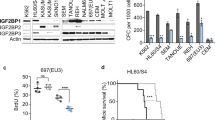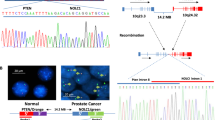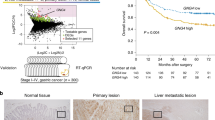Abstract
Two related Rho GTPase-activating proteins, DLC-1 (deleted in liver cancer 1) and DLC-2, are emerging as bona fide tumor suppressor genes that inhibit cancer cell growth. In this report, we characterized a gene on chromosome Xq13 that encodes DLC-3 (also known as KIAA0189 and STARD8), a third member of the DLC family. The DLC-3 gene has transcripts with alternative 5′ ends, one of which, DLC-3α, encodes an 1103-amino acid polypeptide highly similar to DLC-1 and DLC-2. A second isoform (DLC-3β) would yield a protein lacking the N-terminal sterile alpha motif domain. The DLC-3 gene is widely expressed in normal tissues, but DLC-3 mRNA levels were low or absent in a significant number of breast, ovarian, liver and prostate cancer cell lines. Using a cancer profiling array to compare matched tumor and normal human tissues, downregulation of DLC-3 mRNA was observed in kidney, lung, ovarian, uterine and breast cancer samples. By quantitative reverse transcriptase–polymerase chain reaction, DLC-3 expression was reduced in primary prostate carcinomas relative to normal prostate tissue. Transfection of human breast and prostate cancer cells with a DLC-3α expression vector inhibited cell proliferation, colony formation and growth in soft agar. These results indicate that deregulation of DLC-3 may contribute to breast and prostate tumorigenesis.
This is a preview of subscription content, access via your institution
Access options
Subscribe to this journal
Receive 50 print issues and online access
$259.00 per year
only $5.18 per issue
Buy this article
- Purchase on Springer Link
- Instant access to full article PDF
Prices may be subject to local taxes which are calculated during checkout







Similar content being viewed by others
References
Alpy F, Tomasetto C . (2005). Give lipids a START: the StAR-related lipid transfer (START) domain in mammals. J Cell Sci 118: 2791–2801.
Avila DM, Zoppi S, McPhaul MJ . (2001). The androgen receptor (AR) in syndromes of androgen insensitivity and in prostate cancer. J Steroid Biochem Mol Biol 76: 135–142.
Bernards A . (2003). GAPs galore! A survey of putative Ras superfamily GTPase activating proteins in man and Drosophila. Biochim Biophys Acta 1603: 47–82.
Bernards A, Settleman J . (2004). GAP control: regulating the regulators of small GTPases. Trends Cell Biol 14: 377–385.
Billuart P, Bienvenu T, Ronce N, des Portes V, Vinet MC, Zemni R et al. (1998). Oligophrenin-1 encodes a rhoGAP protein involved in X-linked mental retardation. Nature 392: 923–926.
Brown MC, Curtis MS, Turner CE . (1998). Paxillin LD motifs may define a new family of protein recognition domains. Nat Struct Biol 5: 677–678.
Carrel L, Willard HF . (2005). X-inactivation profile reveals extensive variability in X-linked gene expression in females. Nature 434: 400–404.
Ching YP, Wong CM, Chan SF, Leung TH, Ng DC, Jin DY et al. (2003). Deleted in liver cancer (DLC) 2 encodes a RhoGAP protein with growth suppressor function and is underexpressed in hepatocellular carcinoma. J Biol Chem 278: 10824–10830.
Denholm B, Brown S, Ray RP, Ruiz-Gomez M, Skaer H, Hombria JC . (2005). crossveinless-c is a RhoGAP required for actin reorganisation during morphogenesis. Development 132: 2389–2400.
Durkin ME, Avner MR, Huh CG, Yuan BZ, Thorgeirsson SS, Popescu NC . (2005). DLC-1, a Rho GTPase-activating protein with tumor suppressor function, is essential for embryonic development. FEBS Lett 579: 1191–1196.
Durkin ME, Yuan BZ, Thorgeirsson SS, Popescu NC . (2002). Gene structure, tissue expression, and linkage mapping of the mouse DLC-1 gene (Arhgap7). Gene 288: 119–127.
Edelson MI, Lau CC, Colitti CV, Welch WR, Bell DA, Berkowitz RS et al. (1998). A one centimorgan deletion unit on chromosome Xq12 is commonly lost in borderline and invasive epithelial ovarian tumors. Oncogene 16: 197–202.
Gomez del Pulgar T, Benitah SA, Valeron PF, Espina C, Lacal JC . (2005). Rho GTPase expression in tumourigenesis: evidence for a significant link. Bioessays 27: 602–613.
Goodison S, Yuan J, Sloan D, Kim R, Li C, Popescu NC et al. (2005). The RhoGAP protein DLC-1 functions as a metastasis suppressor in breast cancer cells. Cancer Res 65: 6042–6053.
Guan M, Zhou X, Soulitzis N, Spandidos DA, Popescu NC . (2006). Aberrant methylation and deacetylation of deleted in liver cancer-1 gene in prostate cancer: potential clinical applications. Clin Cancer Res 12: 1412–1419.
Hanahan D, Weinberg RA . (2000). The hallmarks of cancer. Cell 100: 57–70.
Hers I, Wherlock M, Homma Y, Yagisawa H, Tavare JM . (2006). Identification of p122RhoGAP (deleted in liver cancer-1) Serine 322 as a substrate for protein kinase B and ribosomal S6 kinase in insulin-stimulated cells. J Biol Chem 281: 4762–4770.
Homma Y, Emori Y . (1995). A dual functional signal mediator showing RhoGAP and phospholipase C-delta stimulating activities. EMBO J 14: 286–291.
Jaffe AB, Hall A . (2005). Rho GTPases: biochemistry and biology. Annu Rev Cell Dev Biol 21: 247–269.
Leung TH, Ching YP, Yam JW, Wong CM, Yau TO, Jin DY et al. (2005). Deleted in liver cancer 2 (DLC2) suppresses cell transformation by means of inhibition of RhoA activity. Proc Natl Acad Sci USA 102: 15207–15212.
Li SS . (2005). Specificity and versatility of SH3 and other proline-recognition domains: structural basis and implications for cellular signal transduction. Biochem J 390: 641–653.
McLysaght A, Hokamp K, Wolfe KH . (2002). Extensive genomic duplication during early chordate evolution. Nat Genet 31: 200–204.
Moon SY, Zheng Y . (2003). Rho GTPase-activating proteins in cell regulation. Trends Cell Biol 13: 13–22.
Murakami T, Sakane F, Imai S, Houkin K, Kanoh H . (2003). Identification and characterization of two splice variants of human diacylglycerol kinase η. J Biol Chem 278: 34364–34372.
Nagaraja GM, Kandpal RP . (2004). Chromosome 13q12 encoded Rho GTPase activating protein suppresses growth of breast carcinoma cells, and yeast two-hybrid screen shows its interaction with several proteins. Biochem Biophys Res Commun 313: 654–665.
Nagase T, Seki N, Ishikawa K, Tanaka A, Nomura N . (1996). Prediction of the coding sequences of unidentified human genes. V. The coding sequences of 40 new genes (KIAA0161-KIAA0200) deduced by analysis of cDNA clones from human cell line KG-1. DNA Res 3: 17–24.
Ng IO, Liang ZD, Cao L, Lee TK . (2000). DLC-1 is deleted in primary hepatocellular carcinoma and exerts inhibitory effects on the proliferation of hepatoma cell lines with deleted DLC-1. Cancer Res 60: 6581–6584.
Ponting CP, Aravind L . (1999). START: a lipid-binding domain in StAR, HD-ZIP and signalling proteins. Trends Biochem Sci 24: 130–132.
Qiao F, Bowie JU . (2005). The many faces of SAM. Sci STKE 2005: re7.
Ridley AJ . (2001). Rho family proteins: coordinating cell responses. Trends Cell Biol 11: 471–477.
Sekimata M, Kabuyama Y, Emori Y, Homma Y . (1999). Morphological changes and detachment of adherent cells induced by p122, a GTPase-activating protein for Rho. J Biol Chem 274: 17757–17762.
Seng TJ, Low JS, Li H, Cui Y, Goh HK, Wong ML et al. (2006). The major 8p22 tumor suppressor DLC1 is frequently silenced by methylation in both endemic and sporadic nasopharyngeal, esophageal, and cervical carcinomas, and inhibits tumor cell colony formation. Oncogene [Epub ahead of print].
Sjöblom T, Jones S, Wood LD, Parsons DW, Lin J, Barber TD et al. (2006). The consensus coding sequences of human breast and colorectal cancers. Science 314: 268–274.
Song YF, Xu R, Zhang XH, Chen BB, Chen Q, Chen YM et al. (2006). High-frequency promoter hypermethylation of the deleted in liver cancer-1 gene in multiple myeloma. J Clin Pathol 59: 947–951.
Spatz A, Borg C, Feunteun J . (2004). X-chromosome genetics and human cancer. Nat Rev Cancer 4: 617–629.
Syed V, Mukherjee K, Lyons-Weiler J, Lau KM, Mashima T, Tsuruo T et al. (2005). Identification of ATF-3, caveolin-1, DLC-1, and NM23-H2 as putative antitumorigenic, progesterone-regulated genes for ovarian cancer cells by gene profiling. Oncogene 24: 1774–1787.
Thakur A, Xu H, Wang Y, Bollig A, Biliran H, Liao JD . (2005). The role of X-linked genes in breast cancer. Breast Cancer Res Treat 93: 135–143.
Twigg SR, Mastumoto K, Kidd AM, Goriely A, Taylor IB, Fisher RB et al. (2006). The origin of EFNB1 mutations in craniofrontonasal syndrome: frequent somatic mosaicism and explanation of the paucity of carrier males. Am J Hum Genet 78: 999–1010.
Ullmannova V, Popescu NC . (2006). Expression profile of the tumor suppressor genes DLC-1 and DLC-2 in solid tumors. Int J Oncol 29: 1127–1132.
Van Aelst L, D’Souza-Schorey C . (1997). Rho GTPases and signaling networks. Genes Dev 11: 2295–2322.
Wieland I, Jakubiczka S, Muschke P, Cohen M, Thiele H, Gerlach KL et al. (2004). Mutations of the ephrin-B1 gene cause craniofrontonasal syndrome. Am J Hum Genet 74: 1209–1215.
Wong CM, Lee JM, Ching YP, Jin DY, Ng IO . (2003). Genetic and epigenetic alterations of DLC-1 gene in hepatocellular carcinoma. Cancer Res 63: 7646–7651.
Wong CM, Yam JW, Ching YP, Yau TO, Leung TH, Jin DY et al. (2005). Rho GTPase-activating protein deleted in liver cancer suppresses cell proliferation and invasion in hepatocellular carcinoma. Cancer Res 65: 8861–8868.
Yuan BZ, Jefferson AM, Baldwin KT, Thorgeirsson SS, Popescu NC, Reynolds SH . (2004). DLC-1 operates as a tumor suppressor gene in human non-small cell lung carcinomas. Oncogene 23: 1405–1411.
Yuan BZ, Miller MJ, Keck CL, Zimonjic DB, Thorgeirsson SS, Popescu NC . (1998). Cloning, characterization, and chromosomal localization of a gene frequently deleted in human liver cancer (DLC-1) homologous to rat RhoGAP. Cancer Res 58: 2196–2199.
Yuan BZ, Zhou X, Durkin ME, Zimonjic DB, Gumundsdottir K, Eyfjord JE et al. (2003). DLC-1 gene inhibits human breast cancer cell growth and in vivo tumorigenicity. Oncogene 22: 445–450.
Zhou X, Thorgeirsson SS, Popescu NC . (2004). Restoration of DLC-1 gene expression induces apoptosis and inhibits both cell growth and tumorigenicity in human hepatocellular carcinoma cells. Oncogene 23: 1308–1313.
Acknowledgements
This work was supported by the Intramural Research Program of the National Cancer Institute, NIH.
Author information
Authors and Affiliations
Corresponding author
Rights and permissions
About this article
Cite this article
Durkin, M., Ullmannova, V., Guan, M. et al. Deleted in liver cancer 3 (DLC-3), a novel Rho GTPase-activating protein, is downregulated in cancer and inhibits tumor cell growth. Oncogene 26, 4580–4589 (2007). https://doi.org/10.1038/sj.onc.1210244
Received:
Revised:
Accepted:
Published:
Issue Date:
DOI: https://doi.org/10.1038/sj.onc.1210244
Keywords
This article is cited by
-
SH3 domain regulation of RhoGAP activity: Crosstalk between p120RasGAP and DLC1 RhoGAP
Nature Communications (2022)
-
Functional analysis of the Drosophila RhoGAP Cv-c protein and its equivalence to the human DLC3 and DLC1 proteins
Scientific Reports (2018)
-
ARHGAP10, downregulated in ovarian cancer, suppresses tumorigenicity of ovarian cancer cells
Cell Death & Disease (2016)
-
A phosphorylation switch controls the spatiotemporal activation of Rho GTPases in directional cell migration
Nature Communications (2015)
-
PKA-induced dimerization of the RhoGAP DLC1 promotes its inhibition of tumorigenesis and metastasis
Nature Communications (2013)



